| 1 |
 |
Page 1
“...Published by the Chefoo Schools Association
The Chefoo Magazine
CHEFOO r*01'SCHOOLS ASSOCIATION
2015
FEATURED IN THIS ISSUE
Chefoo Reconsidered, by David Houliston 9
Recollections of the Three Hills hostel, by Miriam (Birch) Thompson 21
Recollections of Maxwell House, by Tim Reynolds 23
Crossed Laterality, a Kuling Experiment, by Ian Grant, with Kathleen Phillips 29
The Life of the Headmaster's Daughter, by Jean (Bruce) Goodwin 31
Selling Securities in the Place of Confucius, by James McMullan 35
Repatriation of Chefusians, a Summary, by Ian Grant 36
The Challenge of getting an education while Interned, by Estelle (Cliff) Horne 38
Full Table of 3
Children at the Chefoo School in the Cameron
Highlands, Malaysia, 1970s...”
|
|
| 2 |
 |
Page 2
“...children and youth quite radically. In Model 'B' they established small boarding schools in a number of SE Asian countries, (a list can be reviewed on the back cover of this magazine). These were, in the China model, Prep Schools for the younger children from ages 5 or 6 to around 10 years of age. As in the China model, it was the expectation that all OMF missionaries with children of these ages must send their children to one of these schools, depending on where they were stationed. The other radical change from Model 'A' was that as children reached adolescence they were sent to their home countries where hostels (in today's terminology we would call them group homes) were established to provide a home for these children and youth, with the provision of local schooling that was not the direct responsibility of OMF. Some of these schools were private Christian schools, while others were local public schools. There were exceptions, such as in New Zealand where a small number of children...”
|
|
| 3 |
 |
Page 3
“...ARCHIVES
If you have pictures or documents related to Chefoo Schools, please consider passing them on to central archival locations:
• In the UK, Rebecca Mackensie will assist you to place them in the CIM/OMF/CSA archive collection at the University of London, School of Oriental and African Studies.
Telephone Rebecca in London at 00 44 (0) 7944 393, or contact her by email at rebeccamackenzie(a)amail.com
• In Australia and New Zealand, contact Marjorie Keeble by email at m.keeble(a)biapond.com.
• In North America, Ian Grant will assist you to place your documents with the CIM/OMF/CSA collection at the Billy Graham Archives at Wheaton College, Wheaton, Illinois.
Chefoo(a)roaers.com
POST CHINA YEARS
OMF HOSTELS
KULING
YANTAI (CHEFOO)
BOOKS
DEPARTMENTS
CONTENTS
Chefoo Reconsidered, by David Houliston
OMF Letter of Apology
Some Responses to the OMF Letter of Apology
Is there a connection between Chefoo Reconsidered, and the
Chefoo Schools Association? by Ian Grant
Recollections of Three Hills, by...”
|
|
| 4 |
 |
Page 4
“...Call Home."]
A final impetus to OMF that persuaded them to move away from Model 'B' was one or two surveys they administered in the 1970's to solicit the views of former Chefusians, primarily from the China period. This is elaborated on in my essay, commencing on page 18, "Is there a Connection between Chefoo Reconsidered and the Chefoo Schools Association?" This culminated in the publication of Sheila Miller's OMF commissioned history of the Chefoo School, named Pigtails, Ponytails and the Old School Tie.
Moving then to Model 'C', David Dyneka wrote: "There is a diversity of options now used by families, including national schools, international day schools and various forms of home schooling, including internet schooling. Each option has its own advantages and drawbacks. Boarding homes/hostels still have a place when parents choose a schooling option farther afield as the best for the child." There are Home and Field Advisors who assist parents to work out the best approach for their children...”
|
|
| 5 |
 |
Page 5
“...Page 5
Chefoo Magazine, 2015
AN IMPORTANT ANNOUNCEMENT
RESTRUCTURING THE CHEFOO SCHOOLS ASSOCIATION
The Constitution of the Chefoo Schools Association states that the Executive of the UK Branch also holds the executive function of the Association, named the General Council. At the 2014 Reunion in London the UK
Branch formalized their decision to disband, "effective immediately." Their last act before disbanding was to unanimously pass this resolution:
"Be it resolved that the constitution of the Chefoo Schools Association be revised immediately to transfer the function of the executive council of the Association from the executive of the UK branch, which is hereby resigning, to the senior positions in the remaining Association branches for New Zealand, Australia and North America."
Peter Bazire, the outgoing Chair of the UK Branch, stated: "By virtue of this change in our Constitution the current General Council is made up of Marjorie Keeble, (CSA President and Secretary/Treasurer of the...”
|
|
| 6 |
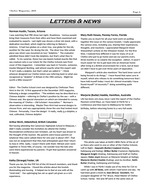 |
Page 6
“...experts. Last night was shown a silver ink stand, with a dedication inscribed, which might be referring to Nelson's mistress. It had two globes on a silver tray, one globe for the ink, another for the sand, for drying the ink. The silver tray (the whole piece was silver) was mounted on two "dolphins." The evaluator admitted these didn't look like dolphins, but that's what they're called. To my surprise, these two sea-beasts looked exactly like that sea creature who is our totem for the Chefoo Schools (see front cover of this magazine). I remember way back in Toronto, someone, maybe Margaret Bunting, said almost exactly what this expert said: 'It isn't really a dolphin, but that's what we called it." I think whoever designed our Chefoo totem was referring back to what was recognized as "dolphin" in Britain in the 19th century. Might be worth a little research?
Editor: The Chefoo School crest was designed by Chefusian Theo Hirst in the UK. It first appeared in the December 1935 magazine, following...”
|
|
| 7 |
 |
Page 9
“...Chefoo Magazine, 2015
CHEFOO SCHOOLS IN THE POST-CHINA YEARS
CHEFOO RECONSIDERED
By David Houliston
Introduction
It was unprecedented. An OMF Director General was apologizing to a group of some seventy Chefusians and their companions for the mistakes made by the previous leadership, which had had a profound and negative effect on the lives of those who had been to Chefoo in the past. Where we sat was what had once been a boy's dorm -where we once laid in bed at night after lights out, our hearts aching for our
mums and dads and homes many miles away.
Once again night had fallen. For many of us this would be the first night at Chefoo in forty to fifty years. Patrick Fung spoke of his heart-felt regret at what had happened and said he understood the pain of separation which he had similarly experienced when his daughter had had to return to Hong Kong from Pakistan for study for some years. After reading out the OMFs "Open letter to adult TCKs" he asked that we might bring ourselves to forgive...”
|
|
| 8 |
 |
Page 14
“...Highlands of Malaya. This seemed an ideal provision at the time - secure, with an equitable climate and relatively close to parents. However, the new school only operated at primary level, and senior education was in the home countries so that children might be prepared for future life there. Although some children lived with relatives or close friends, others were sent to boarding schools and OMF set up hostels to care for their out-of-school needs. Airfares were very expensive at the time and children's visits to their parents were very limited.
We expected that all children would go to one of the Chefoo schools. The message we gave to both parents and children was that the needs of evangelization in Asia was urgent and that this was a sacrifice that God required. Educational options in the place of ministry often did not exist. The Mission leadership thought that we were acting in the best interests of the Gospel and children. Our attitudes were shared by other parts of the Mission world...”
|
|
| 9 |
 |
Page 15
“...long I confused my parents, OMF and God which led me to believe that God had also abandoned me. I believed that God could not or would not intervene for me. It has taken me decades to realize that His love and protection were constantly present.
Nigel: last week I attended a meeting for trainee ministers for the Church of England at which the speaker commented to the audience of new recruits: 'We often get people who believe that they shouldn't have to shunt their children around to different schools as they move around the country, but...,' nodding to her fellow seniors on the platform ... 'we all had to do it with ours.' It seems to me Christians are particularly bad at this kind of 'badge of honour' stuff in organizational settings. Coercion, group pressure, insinuation of lacking commitment... Is this institutional manipulation, or is it bad behavior by manipulative individuals? When my kids look back one day and question why they got jerked around for the sake of 'my calling,' is it...”
|
|
| 10 |
 |
Page 18
“...Chefoo Magazine, 2015
The formation of the Chefoo Schools Association (CSA)
SA was formed in 1908 by former Chefoo School students in the UK who wanted to form a classic school alumni organization. It almost immediately spread to North America, Australia, and New Zealand, and even to Shanghai where quite a number of Chefusians lived and worked. It was meant to be a way for alumni to keep in touch with one another, reminisce about their days at school, and encourage one another in the development of their education strategies, careers, falling in love and raising families. While it operated separately from the CIM, current and former teachers were always welcome, both as members, and in leadership roles. This relationship carried on until the time when teachers were either too old, or had died - no doubt they are all dead now. So the CSA was a positive movement, a way to celebrate friendships, a romantic schooling in China, a love of the ocean in Chefoo, or the mountains in Kuling. Whether...”
|
|
| 11 |
 |
Page 19
“...specifically, we believe it was completed in 1976. Its purpose was to examine the effect of CIM/OMF's policy of educational provision for the children of missionaries which involved separation from parents. The report says that "This brings many queries from those outside the mission." It included children whose parents were from Canada, the USA, Australia, New Zealand and the U.K. In addition to a questionnaire, respondents were invited to write letters with their comments about their Chefoo Schools' experiences. Here is a sampling:
• A few mentioned that the survey was "extremely superficial," and "totally inadequate." And there was "not enough information to be valuable." Someone thought that it was "poorly constructed" and another remark was: "I feel that this Survey does not even begin to scratch the surface of the problem M.K.s have."
• Another writer complained that we have not distinguished between "the effects of long separation from parents which had very little adverse effect and...”
|
|
| 12 |
 |
Page 20
“...section of the dissertation dealing with the presentation and analysis of Mary and Kathleen's stories (see "The Impact of Chefoo and Weihsien: Students' Perspectives.") Based on the comments I received from those who read it, it was well received. To our knowledge Christina Spink (still a dues paying associate member of CSA) has not published her dissertation, but it can be acquired in MS form (go on-line and search for UMI Dissertation Services).
Will a formal link develop between the Chefoo Schools Association & the Chefoo Reconsidered Movement?
Apparently some Chefusians are seeing CRM to be a challenge to CSA. This is not the case. CRM, as it has been pointed out, has come about for an entirely different purpose. Should it evolve into CSA, or into a different sort of organization, or have a short life when its primary purpose is fulfilled, only time will tell.
It is apparent that the CRM will not be simply a single event that took place in Malaysia in October 2014. A follow-up is now...”
|
|
| 13 |
 |
Page 22
“...input. The first missionary from my home church at the turn of the century went out to serve at Chefoo School, and ended up marrying the General Director of the CIM!
But one area where we have remained different from our counterparts in North America, UK, Australia and elsewhere, is in our handling of MKs (or TCKs as we know them today). We've never run hostels or made corporate provisions for young people returning from the field without their parents, or had official links with particular schools or boarding establishments.
There are two basic reasons for this - the relatively small numbers involved, and the fact that in many cases family provisions have been available or the parents have returned from the field with their children.
Statistically it's hard to calculate the numbers involved, for many (as elsewhere) have now passed on. The remnants of the China era are steadily decreasing, while the later generations remain.
Anecdotally there have been one or two from the China era who...”
|
|
| 14 |
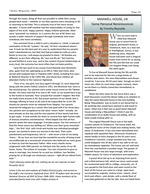 |
Page 23
“...sets of parents to give us away in marriage, two homes for us and our children, two families praying for us through our missionary careers - right till we retired from Asia! "
'God's blessing makes life rich; nothing we do can improve on God.' Proverbs 10:22
Linton is the son and nephew of Chefoo (China) pupils, and served on the staff in the Cameron Highlands from 1975-78 before later becoming National Director of OMF NZfrom 1998-2002. Many members of his extended family have links with Chefoo schools. ♦
MAXWELL HOUSE, UK
Some Personal Reminiscences
By Timothy Reynolds
When we were told in 1968 that Maxwell House was to move from its original, permanent home, in Chislehurst, Kent, to a new site in Warlingham, Surrey, it was shattering news. Maxwell House had been such a magical home-from-home for us during the 50s and 60s that we could not imagine things ever being the same again.
To live at Maxwell House during the 50s and 60s was to be inducted for life into a large family of brothers and...”
|
|
| 15 |
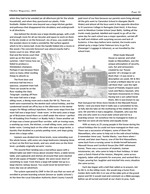 |
Page 24
“...The second floor landing was a marvellous space with a billiard table (we didn't know about snooker then), a table-tennis table, and cupboards and shelves all around that were stacked full of old copies of Reader's Digest. We were never short of something to read. From there a large loft ladder led up to a large electric railway layout. You could never be bored here— every day was an adventure.
The system operated by OMF in the UK was that we were all enrolled in private boarding schools (known as 'public schools'). At the time the Local Education Authority (Kent County Council)
paid most of our fees because our parents were living abroad. All the girls went to Clarendon School in Abergele (North Wales) and almost all the boys went in the opposite direction to St Lawrence College in Ramsgate (East Kent). A few boys went to Monkton Combe School (near Bath). Getting all the trunks ready (packed, labelled and roped) to go off on the same day for each school was a major operation, carried off...”
|
|
| 16 |
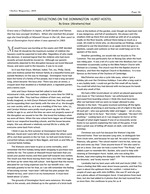 |
Page 26
“...and had fondly imagined, so Anti (Gwyn Watson) told me, that they would just be expanding their own family with the nine of us. We brought our own society with us, so it was a melding of the two. John, Liz, and Carolyn Watson were pretty much grown up, but Hilly was similar in age to us, and at the time we were not properly aware of the disruption we caused to her life. She loved the holidays when we were all there. When the new school term began we all headed back to our respective boarding schools, and the house became empty. She was allowed a relatively normal life for a while, till everyone came back from school.
I think it was my first summer at Donnington Hurst that Michael, David and I were left at the home while the others went off to visit their parents in the Far East. So Anti and Uncle hired a converted railway carriage in New Biggen, and took us and Hilly on a normal family holiday.
The Watsons were keen to give us some normality, and I remember the first holiday being taken...”
|
|
| 17 |
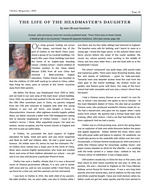 |
Page 31
“... English education. Chefoo School was founded so
that the children of CIM staff could go to school in China, rather than living for many years at schools in the 'home' countries away from their parents.
My father, Pat Bruce, was Headmaster from 1930 to 1945, and we lived in our own wing of the main boys' school building. Since 1910, my parents had worked in the far west of China with the CIM. After seventeen years in China, my parents resigned from the CIM and returned to England with their five young children (I was not yet born), and bought a house in Gloucestershire. However, after eighteen months happily settled there, my father received a letter from CIM Headquarters asking him to become Headmaster of Chefoo School - much to my mother's horror, I think. After anguished prayer, Pat (and my mother, Jessie) accepted, and Pat toured schools in England and the USA to pick up useful ideas.
In Chefoo, he promoted the best aspects of English education for body, mind and spirit, and was much...”
|
|
| 18 |
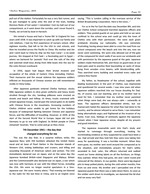 |
Page 32
“...very fast runner, and he just managed to jump onto the end of the train, holding thermos flasks of hot water! I remember I lost my ball out of our compartment, as it went down the corridor, and I never found it. Finally, we arrived by boat in Harwich.
We rented a house and had a 'home life' in England for two years until 1938. It was important to catch up with our family and visit relatives. I had my first experience of nursery school. After eighteen months, Dad left to for the USA to visit schools, and then he travelled across the Pacific to China. My mother and Jim and I went back to China by ship via the Suez Canal - a six-week journey. We stopped at Port Said - a fascinating port in Egypt -where we bartered for 'pomelo' fruit over the rails of the ship and watched small boys diving from little boats into the sea for the coins thrown overboard.
In 1936, Japan had begun their brutal invasion and occupation of the whole of Eastern China (including Chefoo). Their massacres and the sexual...”
|
|
| 19 |
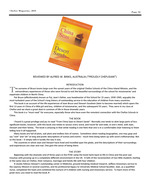 |
Page 34
“...large over the sunset years of the original Chefoo Schools of the China Inland Mission, and the extraordinary experiences of those who were forced to exit the beautiful surroundings of the school for missionaries' and expatriate children in North China.
Pat Bruce (affectionately known as Pa), Jean's father, was headmaster of the School for 15 years, 1930-1945, arguably the
most turbulent years of the School's long history of outstanding service in the education of children from many countries.
This book is an account of the life experiences of Jean Bruce and Stewart Goodwin (later to become married) which spans the
first 13 years in China of a little girl and boy, children of missionaries, and the subsequent 55 years. They were in my class at Chefoo and we share a great deal in common of life in those dramatic years.
This book is a "must read" for everyone, especially those who have even the remotest connection with the Chefoo Schools in China.
THE BOOK
I found it a great privilege and...”
|
|
| 20 |
 |
Page 38
“...study anything but Scripture on Sundays, so I was trying to remember the routes of St. Paul's three missionary journeys.
Finally the day came and we started our exams - two subjects a day as I recall. People have wondered where the exam papers came from. I assume that they were the papers of the other half-year, which we would have received from Oxford for practice papers. I know when the War started the teachers realized that ships could be sunk on their way to us, so they had reserved extras. (Schools start their academic year at different times.) The teachers marked the papers, and gave us tentative results, but "Pa" took the three sets personally to Oxford, who accepted them, not least because Chefoo had always been a prime school, sometimes described as "the best school east of Suez."
My parents had been bombed out of their mission station in Honan, and made their way to Chungking and then to Kunming. The British Army was sending supplies to...”
|
|